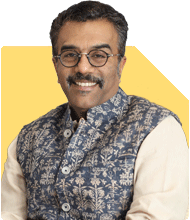Ramalingam Kalirajan |6041 Answers |Ask -Follow
Mutual Funds, Financial Planning Expert - Answered on Jul 16, 2024
He has an MBA in finance from the University of Madras and is a certified financial planner.
He is the director and chief financial planner at Holistic Investment, a Chennai-based firm that offers financial planning and wealth management advice.... more

Dear Sir I am 47 year old and planning to retire by 55.i have sips in MF for 1.5 lacs and my current portfolio is 75 lacs.started investments in sip from year 2021 and hoping to continue till 55 with at least 10% stepup.In addition , i have an FD of 1.4 crores and employee gratuity of 1 crores which will be received at retirement.i have 2 real estate properties an apartment and a small home where my parents are staying presently.what action can be done futher to make my investments 10cr at the age of 55. Thank you Regards Kumar
Goal Evaluation
Your target is to have Rs 10 crores by age 55. With a structured investment plan, this goal can be achieved.
Investment Strategy Analysis
Your monthly SIPs with a 10% step-up are commendable. The current portfolio shows good growth potential. However, to meet the Rs 10 crore goal, further optimization is needed.
Disadvantages of Direct Funds
Direct funds require constant attention and expertise. Regular funds managed by a Certified Financial Planner (CFP) can provide professional advice and better returns. This ensures your investments are well-aligned with your financial goals.
Recommendations
Increase SIPs Gradually: Continue with your SIPs and increase them by at least 10% yearly.
Professional Management: Invest through regular funds managed by a CFP. This offers better portfolio management and aligns with your goals.
Diversify Portfolio: Ensure a mix of large-cap, mid-cap, and balanced funds. This diversification reduces risk and maximizes returns.
Review and Rebalance: Regularly review and rebalance your portfolio with the help of a CFP. This keeps your investments on track to meet your goal.
Final Insights
Your goal to reach Rs 10 crores by 55 is achievable with disciplined investing. Gradually increase your SIPs, diversify your portfolio, and seek professional management. Regular reviews and adjustments will help you stay on track.
Best Regards,
K. Ramalingam, MBA, CFP,
Chief Financial Planner,
www.holisticinvestment.in
You may like to see similar questions and answers below
Ramalingam Kalirajan |6041 Answers |Ask -Follow
Mutual Funds, Financial Planning Expert - Answered on Jul 10, 2024
Ramalingam Kalirajan |6041 Answers |Ask -Follow
Mutual Funds, Financial Planning Expert - Answered on Jul 10, 2024
Ramalingam Kalirajan |6041 Answers |Ask -Follow
Mutual Funds, Financial Planning Expert - Answered on Jul 27, 2024
Chocko Valliappa |420 Answers |Ask -Follow
Tech Entrepreneur, Educationist - Answered on Aug 24, 2024
Chocko Valliappa |420 Answers |Ask -Follow
Tech Entrepreneur, Educationist - Answered on Aug 24, 2024
Nayagam P P |3520 Answers |Ask -Follow
Career Counsellor - Answered on Aug 24, 2024
Radheshyam Zanwar |614 Answers |Ask -Follow
MHT-CET, IIT-JEE, NEET-UG Expert - Answered on Aug 24, 2024
Dr Dipankar Dutta |473 Answers |Ask -Follow
Tech Careers and Skill Development Expert - Answered on Aug 24, 2024
Ramalingam Kalirajan |6041 Answers |Ask -Follow
Mutual Funds, Financial Planning Expert - Answered on Aug 24, 2024
Radheshyam Zanwar |614 Answers |Ask -Follow
MHT-CET, IIT-JEE, NEET-UG Expert - Answered on Aug 24, 2024
Radheshyam Zanwar |614 Answers |Ask -Follow
MHT-CET, IIT-JEE, NEET-UG Expert - Answered on Aug 24, 2024

You have said, your son has the option of BBA in BIT Mesra. i.e. Is there any other option is open to him or just asking about BBA, is not clear. But if you are an option for BBA, then there is no need to worry much. Doing BBA @ BIT is a good option.
BBA has a lot of job opportunities. Over time, as he completes his degree, new job opportunities will be created.
Meanwhile, ask him to complete some BBA and computer-related basics online/offline courses to excel and become job-ready.
If you are not satisfied with the reply, pl ask again without any hesitation.
If satisfied, please like and follow me.
Thanks
Radheshyam
If you are living in Mathura, then choose BVIMR Delhi.
Best of luck to your son for a bright future.
If satisfied, please like and follow me.
Thanks
Dr Karthiyayini Mahadevan |1030 Answers |Ask -Follow
General Physician - Answered on Aug 24, 2024
Dr Karthiyayini Mahadevan |1030 Answers |Ask -Follow
General Physician - Answered on Aug 24, 2024























